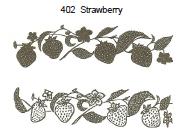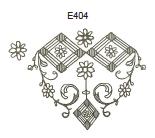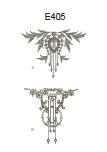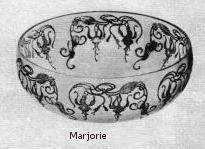The Early History of Cambridge Etchings
By Mark Nye
Issue No. 417 - April 2008
At the November quarterly NCC, Inc. membership meeting, Lynn Welker presented an excellent program on Cambridge etchings using examples from the Museum collection along with a wide array of items brought to the meeting by members. Lynn's presentation included the entire gamut of Cambridge etchings, from the first etchings through those produced by the reorganized company during the period known as the reopen years. Due to time constraints, he was not able to go into great detail about the history of Cambridge etchings or about any specific etching. This article will take a look at the early history of Cambridge etchings.
Cambridge began making glass in May 1902 but it was not until some ten years later that they began to produce the thin blown and paste mold ware typically used as blanks for etching. The April 11, 1912 issue of Crockery and Glass Journal carried this item:
"L. A Fletcher, a well known glass factory man, this week assumed the business management of the Byesville plant of the Cambridge Glass Co. …On Monday Mr. Fletcher went to Byesville where hereafter the plant will make a specialty of thin blown and paste mold work ..."
It is not clear how long Mr. Fletcher lasted at Byesville for the September 19 issue of the same trade journal had this to say:
"Samuel P. Kinney, formerly with the Economy Tumbler Co., but now manager of the Byesville plant of the Cambridge Glass Co., was a visitor in Pittsburgh last week."
There was a full page Cambridge advertisement in the December 23, 1912 issue of China, Glass and Lamps. The text read in part:
"We now ask your attention to our NEW DEPARTMENT. We are producing a most excellent line of high grade, lead blown stemware, tumblers, etc., both in plain, optic, needle etched, deep plate etched and light cut patterns."
Thus we have the first trade journal reference to deep plate etching being done by the Cambridge Glass Co. What is interesting is that from this point on, until the demise of the original Cambridge Glass Co., the blown ware department was referred to as the "Byesville Department" even after the Byesville plant was closed ( circa 1920-1921) and the manufacture of blown ware moved to the main plant in Cambridge.
Very little mention is made of Cambridge produced etched ware in the trade journals for 1913. Crockery and Glass Journal for January 23, 1913 makes mention of:
"Blown tumblers and stemware, plain and decorated, are new features of the Cambridge Glass Co. this year and a long line of each is given a prominent display in the [Pittsburgh] exhibit."
Trade journal descriptions of the Cambridge exhibit at the 1914 Pittsburgh Exhibit made little reference to the relatively new lines of etchings and then it was mostly indirectly:
"Then, on the long shelving against the rear wall of the room were beauties in what are called "stem" ware but what the plain ordinary people would style tumblers or goblets, for fancy table decoration." This was what attracted attention. They were delicate and beautifully decorated, and while dainty enough to impel one to hold his breath while handling a piece, were rich enough in real beauty to appeal to the most ordinary visitor." China, Glass, Lamps January 19, 1914
Later in the year, the March 19 issue of Crockery and Glass Journal had this to say:
A full line of stemware as well as a number of pieces in a new copyrighted Strawberry design in a deep plate etching is one of the latest additions to the Cambridge Glass Co.'s stock being shown by sales manger D. King Irwin. The shape is the well known "Touraine" already made popular by the Cambridge Glass. Co.
In December 1914 this item appeared, again in Crockery and Glass Journal:
"A complete assortment of stemware and numerous other items in a beautiful and novel design and shape, for both of which D. King Irwin is responsible, is now being shown at the salesroom of the Cambridge Glass Co. This is not the first time Mr. Irwin has demonstrated his ability as a designer, but he has never turned out anything prettier than this cleverly arranged Fuschia pattern in a deep plate etching on a shape that is out of the ordinary and exactly suited to the design."
This, of course, is the etching we now know as Marjorie, probably named in honor of Mr. Bennett's daughter, Marjorie. From the commentary found in the trade journals along with Cambridge advertising, it can be concluded that Cambridge began deep plate etching some time in 1912. The trade journals continued to pay more attention to the old lines which were the "standards" of the period. Etched glassware for home use was still the "new kid on the block."

 The first appearance of deep plate
etchings in a Cambridge catalog occurred in one titled "Catalog of Lead Blown Tumblers and Stemware" and issued circa 1913. In this
catalog appear the first commercial etchings produced, a total of seven being shown. All
have numbers; the first number being used was No. 401. This etching was also named
Grape Vine Design. No. 402 was named Strawberry Design and for some reason, unknown
to today's collectors, No. 403 never made it into the catalog nor is it known what it looked
like. The balance of the etchings shown in this catalog did not have names, only numbers:
Nos. 404, 405, 406, 407 and 408. There is a comment on each catalog page showing
etchings that reads: "For Full Line of Etchings See Price List." Unfortunately for us today,
the price list has not survived. Whether this means there were more etchings being offered
The first appearance of deep plate
etchings in a Cambridge catalog occurred in one titled "Catalog of Lead Blown Tumblers and Stemware" and issued circa 1913. In this
catalog appear the first commercial etchings produced, a total of seven being shown. All
have numbers; the first number being used was No. 401. This etching was also named
Grape Vine Design. No. 402 was named Strawberry Design and for some reason, unknown
to today's collectors, No. 403 never made it into the catalog nor is it known what it looked
like. The balance of the etchings shown in this catalog did not have names, only numbers:
Nos. 404, 405, 406, 407 and 408. There is a comment on each catalog page showing
etchings that reads: "For Full Line of Etchings See Price List." Unfortunately for us today,
the price list has not survived. Whether this means there were more etchings being offered

 (somewhat doubtful) or that more items than those shown were available with the etchings
(most likely) is not known with complete certainty.
(somewhat doubtful) or that more items than those shown were available with the etchings
(most likely) is not known with complete certainty.
No. 401 or Grape Vine Design was pictured on the No. 7390 9 oz goblet, several pieces of No. 300 stemware, two tumblers, two styles of master almonds with individuals to match, and the No. 7605 25 oz. grape fruit. The elusive Strawberry Design or No. 402 etching (It has yet to be seen on an actual piece of glass.) was also illustrated on items from the same two stemware lines as No 401, Nos. 7390 and 300, as well as a tumbler and a fingerbowl. Illustrated in the 1913 catalog is the No. 7390 1 oz. cordial, etched Strawberry. (Dream on cordial collectors!) The other five etchings, Nos. 404, 405, 406, 407, and 408 were each shown on a single piece, with the exception of No. 405 being shown on both the No. 7390 5 oz. parfait and the No. 9415 9 oz. flat tumbler.
No 401, Grape Vine Design, remained in the Cambridge line until the mid 1920s and then was revived in the 1930s under several names, Old Fashioned Grape, Grape, Bacchus and Vintage. Strawberry simply disappears. It remains a mystery why no piece has ever been reported. A single etching plate survives and is in the NCC, Inc. collection.

No. 404 was discontinued before the beginning of the 1920s and no etching plates survive which is also true for the original version of No.405, as seen in the 1913 catalog. For unknown reasons, this same number was used for an entirely different etching that appeared in a Cambridge catalog issued circa 1921. Etching No. 406 is also known only through the illustration in the 1913 catalog as once again, no etching plates exist today. Production of this etching had ceased by the time the 1920s began. Several etching plates for No. 407 survived the passage of time and from one the illustration seen here was taken. Like many of the other early etchings, it too did not survive into the 1920s. The last of the initial Cambridge etchings, No. 408, was also discontinued by 1920 but then combined with a border etching, No. 625, and renamed Wedgewood. No. 408 was also joined with another border etching, this one being No. 619, with the combination known as Plate Etching No. 5. Both of these combinations appeared in a Cambridge catalog issued circa 1921 but were out of the line by 1927. More on these combination etchings in a future article.
 The best known of the early etchings is Marjorie. Introduced in late 1914, it proved to be a popular design and is readily found today,
particularly on stemware. Jugs and plates can also be found and added to one's collection. Marjorie was placed on 7606 stemware and
the combination remains almost as popular today as it was when first offered. Many collectors use their Marjorie etched stemware
when entertaining and some on a daily basis, this writer being among the latter. Marjorie stemware was produced until the very late
1920s. The etching was later revived in the early 1930s as Etching No. 764 and offered on a console set, consisting of the No. 1307
candelabrum and the No. 1349 12 in. bowl.
The best known of the early etchings is Marjorie. Introduced in late 1914, it proved to be a popular design and is readily found today,
particularly on stemware. Jugs and plates can also be found and added to one's collection. Marjorie was placed on 7606 stemware and
the combination remains almost as popular today as it was when first offered. Many collectors use their Marjorie etched stemware
when entertaining and some on a daily basis, this writer being among the latter. Marjorie stemware was produced until the very late
1920s. The etching was later revived in the early 1930s as Etching No. 764 and offered on a console set, consisting of the No. 1307
candelabrum and the No. 1349 12 in. bowl.
By 1921, etchings were fast becoming a major player in the Cambridge line and for years to come, new etchings were introduced almost every year. Several dinnerware lines were designed as blanks to be used for etching, lines such as the Decagon, Round, No. 3400, Gadroon or No. 3500, Martha, and Corinth. For more information about Cambridge etchings, the interested collector is urged to obtain a copy of Cambridge Glass Company Etchings, published by NCC, Inc.
